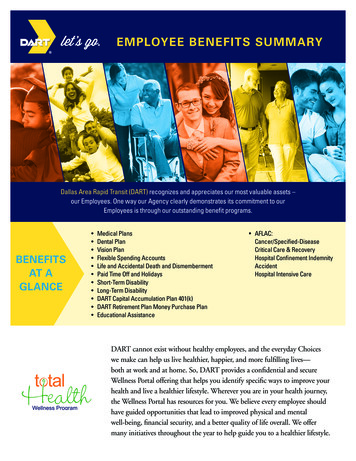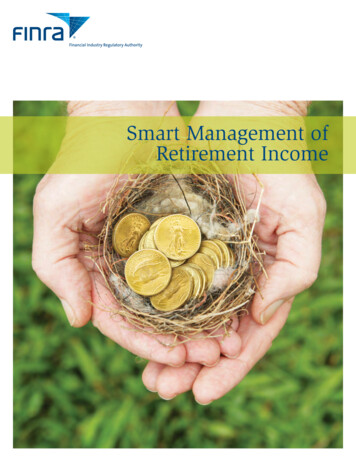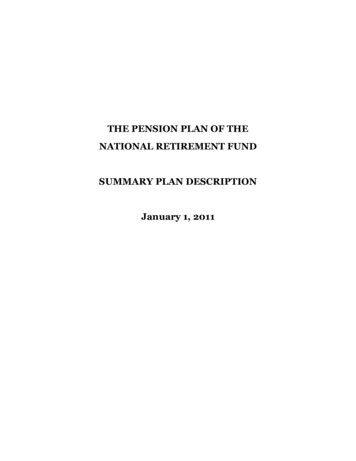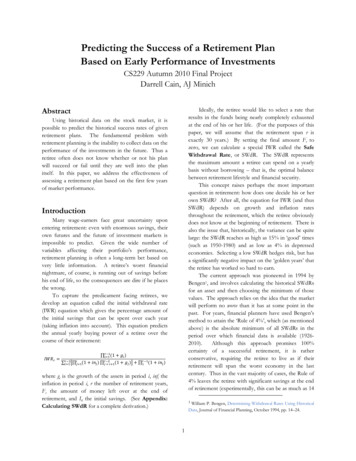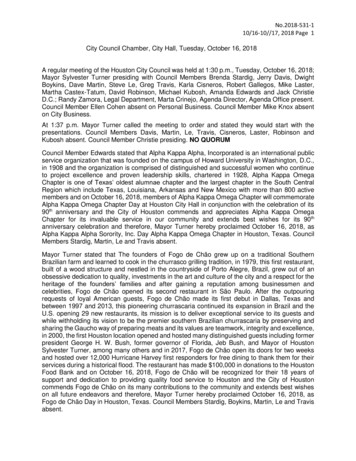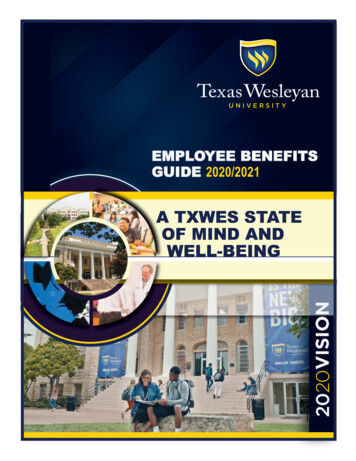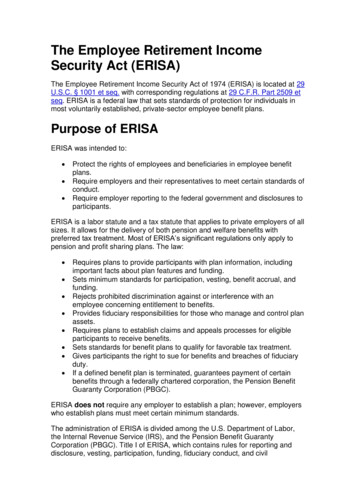
Transcription
The Employee Retirement IncomeSecurity Act (ERISA)The Employee Retirement Income Security Act of 1974 (ERISA) is located at 29U.S.C. § 1001 et seq. with corresponding regulations at 29 C.F.R. Part 2509 etseq. ERISA is a federal law that sets standards of protection for individuals inmost voluntarily established, private-sector employee benefit plans.Purpose of ERISAERISA was intended to: Protect the rights of employees and beneficiaries in employee benefitplans.Require employers and their representatives to meet certain standards ofconduct.Require employer reporting to the federal government and disclosures toparticipants.ERISA is a labor statute and a tax statute that applies to private employers of allsizes. It allows for the delivery of both pension and welfare benefits withpreferred tax treatment. Most of ERISA’s significant regulations only apply topension and profit sharing plans. The law: Requires plans to provide participants with plan information, includingimportant facts about plan features and funding.Sets minimum standards for participation, vesting, benefit accrual, andfunding.Rejects prohibited discrimination against or interference with anemployee concerning entitlement to benefits.Provides fiduciary responsibilities for those who manage and control planassets.Requires plans to establish claims and appeals processes for eligibleparticipants to receive benefits.Sets standards for benefit plans to qualify for favorable tax treatment.Gives participants the right to sue for benefits and breaches of fiduciaryduty.If a defined benefit plan is terminated, guarantees payment of certainbenefits through a federally chartered corporation, the Pension BenefitGuaranty Corporation (PBGC).ERISA does not require any employer to establish a plan; however, employerswho establish plans must meet certain minimum standards.The administration of ERISA is divided among the U.S. Department of Labor,the Internal Revenue Service (IRS), and the Pension Benefit GuarantyCorporation (PBGC). Title I of ERISA, which contains rules for reporting anddisclosure, vesting, participation, funding, fiduciary conduct, and civil
enforcement, is administered by the U.S. Department of Labor. Title II ofERISA, which amended the Internal Revenue Code to parallel many of the TitleI rules, is administered by the IRS. Title III is concerned with jurisdictionalmatters and with coordination of enforcement and regulatory activities by theU.S. Department of Labor and the IRS. Title IV covers the insurance of definedbenefit pension plans and is administered by the PBGC.CoverageERISA applies to most private employers, including for-profit and nonprofitorganizations, regardless of size. ERISA generally applies to all benefit planssponsored by private employers or employee organizations (e.g., labor unions),including self-insured and fully insured plans, so long as the plan is providingretirement benefits, health care, or other ERISA-listed benefits.The following plans are subject to ERISA: Defined benefit pension plans.Defined contribution pension plans.Group health and medical insurance (PPO, HDHP, HMO, POS, etc.).Dental and vision plans.Health Flexible Spending Accounts (FSAs).Health Reimbursement Accounts (HRAs).Prescription drug plans.Disability plans.Life and accident insurance plans.Wellness Programs*.Employee Assistance Programs (EAPs)*.*Wellness programs and EAPs are covered by ERISA if they provide medicalcare.ExemptionsGenerally, ERISA does not cover group health plans established or maintainedby governmental entities, churches for their employees, or plans which aremaintained solely to comply with applicable workers’ compensation,unemployment, or disability laws. In addition, ERISA does not cover plansmaintained outside the United States primarily for the benefit of nonresidentaliens, or unfunded excess benefit plans.The following plans are not covered by ERISA: Government plans (federal, state, city, school district, etc.).Church plans (unless the plan elects to be covered under ERISA).Workers’ compensation, unemployment insurance, or statutory disabilitybenefit plans.Health Savings Accounts (HSAs).Section 125 premium-only plans.
Plans maintained outside the U.S. for nonresident alien employees.Voluntary plans.Benefits funded through payroll practice.Voluntary Plan Safe HarborCertain voluntary insurance plans may be exempt from ERISA. To beconsidered exempt under ERISA’s voluntary plan safe harbor, all of thefollowing requirements must be met: The plan must be completely voluntary.The plan must not allow employer contributions.The plan must not allow the employer to endorse the plan.The plan must not allow the employer to receive any consideration (otherthan reimbursement of administrative expenses).Payroll Practice ExceptionUnder the payroll practice exception, certain benefits payments are exemptfrom ERISA if they are paid solely out of the employer’s general assets. Thesebenefits include overtime pay, unfunded sick pay, paid medical leave, andincome replacement benefits, including short-term disability or salarycontinuation plans.ERISA RequirementsERISA sets uniform minimum standards to ensure that employee benefit plansare established and maintained in a fair and financially sound manner.Additionally, employers have an obligation to provide promised benefits andsatisfy ERISA’s requirements for managing and administering private retirementand welfare plans.Title I of ERISA requires persons and entities that manage and control planfunds to: Manage plans for the exclusive benefit of participants and beneficiaries.Carry out their duties in a prudent manner and refrain from conflict ofinterest transactions expressly prohibited by law.Comply with limitations on certain plans’ investments in employersecurities and properties.Fund benefits in accordance with the law and plan rules.Report and disclose information on the operations and financial conditionof plans to the government and participants.Provide documents required in the conduct of investigations to ensurecompliance with the law.Plans covered by ERISA are subject to some or all of the followingrequirements:
Written Plan Documents.Summary Plan Description (SPD).Summary of Material Modification (SMM).Form 5500.Form 5500-SF.Summary of Annual Report (SAR).Fiduciary Standards.Prohibited Transactions and Exceptions.Written Plan DocumentsThe administrator of an employee benefit plan is the individual or entityspecifically designated in the plan documents as the administrator. If the plandocuments do not designate an administrator, the administrator is the employermaintaining the plan, or, in the case of a plan maintained by more than oneemployer, the association, committee, joint board of trustees, or similar grouprepresenting the parties maintaining the plan.ERISA requires plan administrators to provide plan participants notification inwriting of the most important facts about their retirement and health benefitplans including plan rules, financial information, and documents on theoperation and management of the plan. Some of these facts must be providedto participants regularly and automatically by the plan administrator, whileothers are available upon request, free-of-charge or for copying fees. Therequest should be made in writing.Warning: A Certificate of Coverage (COC) is a document provided by theinsurance company that describes a covered person’s coverage benefits,limitations, and exclusions. These documents may not meet the requirements ofERISA for plan documents.Options for plan documents include: Wrap-Around Plan Document creating a combined plan for all insuredbenefits incorporating the COC as part of the SPD. A Wrap Document isa document that “wraps” around the insurance policy, certificate, orbooklet so that the plan sponsor complies with ERISA. The plan benefitscontinue to be governed by the insurance policy, certificate, or booklet,but the Wrap Document supplements that information so that thecombined documents comply with ERISA.Individual Plan with separate Plan Document and separate SPD for eachbenefit.Umbrella Plan combining all welfare benefits into a single plan withseparately bundled or individual SPDs.Summary Plan Description (SPD)The Summary Plan Description (SPD) is the primary vehicle for informingparticipants and beneficiaries about their plan and how it operates. This SPD is
separate and distinct from the Plan Document. It must be written for theaverage participant and be sufficiently comprehensive to apprise coveredpersons of their benefits, rights, and obligations under the plan.SPD RequirementsThe style, format, and content requirements of the SPD are outlined in 29C.F.R. §§ 2520.102-2 and 2520.102-3. Information required in the SPDincludes: The plan name.The plan sponsor/employer’s name and address.The plan sponsor’s federal Employer Identification Number (EIN).The plan administrator’s name, address, and phone number.Designation of any named fiduciaries, if other than the plan administrator(such as claim fiduciary).The plan number for ERISA Form 5500 purposes (501, 502, 503, etc.).Note: Each ERISA plan should be assigned a unique number that is notused more than once.Type of plan or brief description of benefits (life, medical, dental,disability, etc.).The date of the end of the plan year for maintaining plan’s fiscal records(note that this may be different than the insurance policy year).Each trustee’s name, title, and address of principal place of business, ifthe plan has a trust.The name and address of the plan’s agent for service of legal process,along with a statement that service may be made on a plan trustee oradministrator.The type of plan administration (administered by contract, insurer, orsponsor).Eligibility terms, such as classes of eligible employees, employmentwaiting period, and hours per week. and the effective date ofparticipation, such as next day or first of month following satisfaction ofeligibility waiting period.How insurer refunds (such as dividends, demutualization, and medicalloss ratio (MLR) refunds) are allocated to participants.Plan sponsor’s amendment and termination rights and procedures, andwhat happens to plan assets, if any, in the event of plan termination.Summary of any plan provisions governing the benefits, rights, andobligations of participants under the plan on termination or amendment ofplan or elimination of benefits.Summary of any plan provisions governing the allocation and dispositionof assets upon plan termination.Claims procedures, which may be furnished separately in a Certificate ofCoverage (COC), provided that the SPD explains that claims proceduresare furnished automatically, without charge, in the separate document,and time limits for lawsuits, if the plan imposes them.
A statement clearly identifying circumstances that may result in loss ordenial of benefits (subrogation, Coordination of Benefits, and offsetprovisions).The standard of review for benefit decisions.ERISA model statement of participants’ rights.The sources of plan contributions, whether from employer and/oremployee contributions, and the method by which they are calculated.Interim Summary of Material Modifications (SMMs) since SPD wasadopted or last restated.The fact that the employer is a participating employer or a member of acontrolled group.Whether the plan is maintained pursuant to one or more collectivebargaining agreements, and that a copy of the agreement may beobtained upon request.A prominent offer of assistance in a non-English language (depending onthe number of participants who are literate in the same non-Englishlanguage).Identity of insurer(s), if any.Additional requirements for group health plan SPDs, such as:o Detailed description of plan provisions and exclusions (such asco-pays, deductibles, co-insurance, eligible expenses, networkprovider provisions, prior authorization and utilization reviewrequirements, dollar limits, day limits, visit limits, and the extent towhich new drugs, preventive care, and medical tests and devicesare covered). A link to network providers should also be provided,and plan limits, exceptions, and restrictions must be conspicuous.o Information regarding COBRA, HIPAA, and other federalmandates such as Women’s Health Cancer Rights Act, preexisting condition exclusion, special enrollment rules, mentalhealth parity, coverage for adopted children, qualified medicalsupport orders, and minimum hospital stays following childbirth.o Name and address of health insurer(s), if any.o Description of the role of health insurers (such as, whether theplan is insured by an insurance company or the insurancecompany is merely providing administrative services).Summary of Material ModificationAny change to a plan that materially affects the design or administration mustbe reported to plan participants in a Summary of Material Modifications (SMM).The SMM must be distributed within 210 days after the end of the plan year inwhich the modification took place. If the modification is any material reduction inservices or benefits, the SMM must be distributed to all plan participants within60 days of the date the change is made.A reduction in covered services or benefits generally will include any planmodification or change that: Eliminates benefits payable under the plan.
Reduces benefits payable under the plan.Increases premiums, deductibles, co-insurance, co-payments or otheramounts to be paid by a participant or beneficiary.Reduces the service area covered by a health maintenance organization.Establishes new conditions or requirements (e.g., preauthorizationrequirements) to obtaining services or benefits under the plan.Modifications to a plan also require updating SPDs and other plan documents.The SMM gives the participants an interim statement of the changes to the planbefore a new SPD can be issued.Form 5500The Department of Labor, Internal Revenue Service, and the Pension BenefitGuaranty Corporation jointly developed the Form 5500 Series so employeebenefit plans could utilize the forms to satisfy annual reporting requirementsunder Title I and Title IV of ERISA and under the Internal Revenue Code.Certain plans are also required to submit an accountant’s report. Plan sponsorsmust generally file the forms on the last day of the seventh month after theirplan year ends. Form 5558 may be used to request a two and one-half monthextension of the Form 5500 filing due date.All Form 5500 Annual Return/Report of Employee Benefit Plan, all Form 5500SF Short Form Annual Return/Report of Small Employee Benefit Plan, and anyrequired schedules and attachments, must be completed and filed electronicallyusing EFAST2-approved third-party software or using IFILE.Plan administrators should review the Reporting and Disclosure Guide,published by the Department of Labor, for more detailed information regardingfiling Form 5500.Summary Annual ReportDefined contribution retirement plan and welfare plan administrators mustannually provide a Summary Annual Report (SAR), which is a narrativesummary of the Form 5000 to participants and beneficiaries.Fiduciary StandardsPart 4 of Title I sets forth standards and rules for the conduct of plan fiduciaries.Persons who exercise discretionary authority or control over management of aplan or disposition of its assets are fiduciaries for purposes of Title I of ERISA.Fiduciary status is based on the functions performed for the plan, not just aperson’s title.A plan’s fiduciaries ordinarily include the trustee, any investment advisers, allindividuals exercising discretion in the administration of the plan, all members ofa plan’s administrative committee (if it has such a committee), and those whoselect committee officials. Attorneys, accountants, and actuaries generally are
not fiduciaries when acting solely in their professional capacities. The key todetermining whether an individual or an entity is a fiduciary is whether they areexercising discretion or control over the plan.Fiduciaries are required to discharge their duties solely in the interest of planparticipants and beneficiaries and for the exclusive purpose of providingbenefits and defraying reasonable expenses of administering the plan. Indischarging their duties, fiduciaries must act prudently and in accordance withdocuments governing the plan, to the extent such documents are consistentwith ERISA.Section 404(a)(1)(B) of ERISA contains what may be referred to as the “PrudentExpert Standard.” Requiring the fiduciary act with the prudence of one “familiarwith such matters” creates a distinction from the general prudent personstandard. When selecting advisors, employers must demonstrate due diligencein establishing that such advisors meet this standard.The Department of Labor has taken the position that there is a class of activitieswhich relates to the formation, rather than the management, of plans. Theseactivities, generally referred to as settlor functions, include decisions relatingto the formation, design and termination of plans and, except in the context ofmulti-employer plans, generally are not activities subject to Title I of ERISA. TheDepartment of Labor also has taken the position that, while expenses attendantto settlor activities do not constitute reasonable plan expenses, expensesincurred in connection with the implementation of settlor decisions mayconstitute reasonable expenses of the plan.Settlor functions are different from fiduciary functions. An employer, or themanagement of a sponsoring entity, engages in necessary settlor functionswhen establishing a plan, choosing plan design, and amending or terminating aplan. Such business decisions do impact an employee benefits plan;nonetheless, these settlor functions are not governed by the fiduciary dutyprovisions of ERISA.Prohibited Transaction Exemption ProceduresIn order to avoid confusion over dual jurisdiction between the Department ofLabor and IRS, Reorganization Plan No. 4 of 1978 transferred the authority togrant exemptions from the prohibited transaction provisions under the InternalRevenue Code to the Department of Labor. As a result, the Department ofLabor has the exclusive authority to issue prohibited transaction exemptions(PTEs) involving plans that are: Covered solely under Title I of ERISA (welfare benefit plans such asgroup health plans).Covered solely under Title II of ERISA (plans without employees such asnonemployer sponsored IRAs and Keoghs).Covered under both Titles I and II of ERISA (pension and individualaccount plans such as 401(k) plans).
Prohibited TransactionsProhibited transaction provisions prohibit fiduciaries from causing a plan toengage in certain types of transactions with persons referred to as “parties ininterest” under Title I of ERISA or “disqualified persons” under the InternalRevenue Code. The purpose of the prohibited transaction rules is to preventdealings with parties who may be in a position to exercise improper influenceover plan assets, and to prevent plan fiduciaries from taking actions withrespect to a plan which involves self-dealing and conflicts of interest.There are two categories of prohibited transactions. The first category dealswith transactions between the plan and a party in interest with respect to theplan. Specifically, for these transactions a plan fiduciary may not cause a planto enter into a transaction which directly or indirectly constitutes any of thefollowing: A sale, exchange, or leasing of property.A loan or other extension of credit.A provision of goods, services, or facilities.A transfer or use of the income or the assets of the plan.An acquisition and holding of employer securities or employer realproperty that does not meet certain conditions.The second category of prohibited transactions describes situations involvingfiduciary self-dealing and conflicts of interest. For example, a violation mayoccur where a plan fiduciary causes a plan to engage in transactions that maybenefit that plan fiduciary or a person or entity in which the fiduciary has afinancial interest. This second category also applies where a fiduciary acts onbehalf of a party or represents a party whose interests are adverse to theinterests of the plan.Party in Interest/Disqualified PersonParties in interest/disqualified persons are individuals or entities that havedefined relationships to a plan. They include a person providing services to theplan (such as attorneys, accountants, or third-party administrators), anemployer or union whose employees or members participate in the plan, andplan fiduciaries.It is important to note that there are some differences between these two termsunder ERISA and the Internal Revenue Code. For example, the definition of“party in interest” in ERISA includes, among other categories, employees of aplan sponsor, while the corresponding term in the Internal Revenue Code —“disqualified person” — includes only certain highly-compensated employees.ExemptionsThere are a number of exemptions allowing plans to conduct transactionsnecessary for plan operation, but that are otherwise prohibited. Exemptions maybe categorized as statutory exemptions or administrative exemptions.
A statutory exemption may be relied upon provided that the conditions of theexemption are met. One exemption in the law allows a plan to hire a serviceprovider as long as the services are necessary to operate the plan and thecontract or arrangement under which the services are provided and thecompensation paid for those services is reasonable. The law providesexemptions for many plan dealings with banks, insurance companies, and otherfinancial institutions that are essential to the ongoing operations of the plan.Another exemption permits plans to offer loans to participants. To the extentthat a transaction is permitted by a statutory exemption, the parties would notneed to request an administrative exemption for the same transaction from theDepartment of Labor.The department may grant additional exemptions. The exemptions issued bythe department can involve transactions available to a class of plans or to onespecific plan.The Department of Labor has the authority to grant administrative exemptionsfrom the prohibited transaction provisions of ERISA and the Internal RevenueCode for a class of transactions or for individual transactions. In order to grantan administrative exemption, the department must make three determinations:1. The exemption must be administratively feasible;2. In the interest of the plan and its participants and beneficiaries; and3. Protective of the rights of plan participants and beneficiaries.Prior to granting an exemption, the department must publish a notice ofproposed exemption in the Federal Register so that interested persons aregiven the opportunity to comment on the proposal. If the transaction involvespotential fiduciary self-dealing or conflicts of interest, an opportunity for a publichearing also must be provided. The exemption procedures are designed toensure that the department is provided with all the relevant materials that arenecessary to accurately and promptly decide whether or not an exemptionshould be proposed.A class exemption may provide exemptive relief from the prohibited transactionprovisions in ERISA or the Internal Revenue Code, or both, to an identifiedclass of entities or individuals who engage in the transaction(s) described in theexemption and who also satisfy the conditions contained in the exemption.In 1996, the department published a class exemption PTE 96-62, commonlyreferred to as EXPRO. The EXPRO exemption is available for a class ofprospective transactions which meet the conditions contained in PTE 96-62 aswell as the authorization requirements described therein. If the conditions andauthorization procedures are met, an applicant may be able to obtain individualprohibited transaction relief on an expedited basis.Individual exemptions involve case-by-case determinations as to whether thespecific facts represented by an applicant concerning a specific transaction (aswell as the conditions applicable to such a transaction) support a finding by thedepartment that the requirements for relief from the prohibited transactionprovisions of ERISA and the Internal Revenue Code have been satisfied. Unlike
a class exemption, an individual exemption may be relied upon only by thespecific parties in interest named or otherwise identified in the exemption.Parties in interest or disqualified persons that are unable to meet the conditionsof a class exemption also may request an individual exemption. A listsummarizing the department’s most recent individual exemptions is located atwww.dol.gov/ebsa/regs/ind exemptionsmain.html on EBSA’s website.Disclosure and Reporting RequirementsERISA notice requirements are outlined at 29 U.S.C. § 1021.Both pension and welfare benefit plans are required to meet extensivedisclosure and reporting requirements under ERISA. Plan administrators shouldreview the Reporting and Disclosure Guide, published by the Department ofLabor, for more detailed information regarding current reporting requirements.Posting RequirementsERISA has no posting requirements.Recordkeeping RequirementsSection 107 of ERISA (29 U.S.C. § 1027) requires anyone who files anemployee benefit plan report (i.e., Form 5500) to maintain sufficient records tosupport all information included on the report for at least six years from the datethe report is filed. Plan sponsors must generally file Form 5500 on the last dayof the seventh month after their plan year ends. Typically, employers with lessthan 100 participants in a welfare plan at the beginning of the year do not fileForm 5500 for the welfare plan for that year.However, Section 209 of ERISA (29 U.S.C. § 1059) contains a much broaderand open-ended recordkeeping requirement. Section 209 requires employers tomaintain all records necessary to determine benefits that are or may becomedue to each employee.Records that should be maintained include, but are not limited to, the following: Plan documents, including amendments.IRS determination letters.SPDs and SMMs.Participant benefit statements.Company resolutions declaring match and/or profit sharing contributions.Participant notices.Form 5500 (including all required schedules and attachments).Actuarial statements and valuations.Age and service records that are used to determine waiting periods,eligibility, vesting, breaks in service, and benefits.Payroll records.
EnforcementThe administration of ERISA is divided among the U.S. Department of Labor,the Internal Revenue Service of the Department of the Treasury (IRS), and thePension Benefit Guaranty Corporation (PBGC). Title I of ERISA, which containsrules for reporting and disclosure, vesting, participation, funding, fiduciaryconduct, and civil enforcement, is administered by the U.S. Department ofLabor. Title II of ERISA, which amended the Internal Revenue Code to parallelmany of the Title I rules, is administered by the IRS. Title III is concerned withjurisdictional matters and with coordination of enforcement and regulatoryactivities by the U.S. Department of Labor and the IRS. Title IV covers theinsurance of defined benefit pension plans and is administered by the PBGC.ERISA confers substantial law enforcement responsibilities on the Departmentof Labor. The department has the authority to bring a civil action to correctviolations of the law, provides investigative authority to determine whether anyperson has violated Title I (Protection of Employee Rights), and imposescriminal penalties on any person who willfully violates any provision of Part 1 ofTitle I.The Employee Benefits Security Administration (EBSA) has the authority toassess civil penalties for reporting violations. A penalty of up to 2,063 per daymay be assessed against plan administrators who fail or refuse to comply withannual reporting requirements. Section 502(i) gives the agency authority toassess civil penalties against parties in interest who engage in prohibitedtransactions with welfare and nonqualified retirement plans. The penalty canrange from 5 – 100 percent of the amount involved in a transaction.A parallel provision of the Internal Revenue Code directly imposes an excise taxagainst disqualified persons, including employee benefit plan sponsors andservice providers, who engage in prohibited transactions with tax-qualifiedretirement plans.Finally, § 502(l) requires the Department of Labor to assess mandatory civilpenalties equal to 20 percent of any amount recovered with respect to fiduciarybreaches resulting from either a settlement agreement with the Department ofLabor or a court order as the result of a lawsuit by the Department of Labor.Interaction with Other LawsPart 5 of Title I states that the provisions of ERISA Titles I and IV supersedestate and local laws which “relate to” an employee benefit plan. ERISA,however, does not pre-empt certain state and local laws, including stateinsurance regulation of multiple employer welfare arrangements (MEWAs).MEWAs generally constitute employee welfare benefit plans or otherarrangements providing welfare benefits to employees of more than oneemployer, not pursuant to a collective-bargaining agreement.
In addition, ERISA’s general prohibitions against assignment or alienation ofretirement benefits do not apply to qualified domestic relations orders. Planadministrators must comply with the terms of qualifying orders made pursuantto state domestic relations laws that award all or part of a participant’s benefit inthe form of child support, alimony, or marital property rights to an alternativepayee (spouse, former spouse, child, or other dependent). Finally, group healthplans covered by ERISA must provide benefits in accordance with therequirements of qualified medical child support orders issued under statedomestic relations
sponsored by private employers or employee organizations (e.g., labor unions), including self-insured and fully insured plans, so long as the plan is providing retirement benefits, health care, or other ERISA-listed benefits. The following plans are subject to ERISA: Defined benefit pension plans. Defined contribution pension plans.


